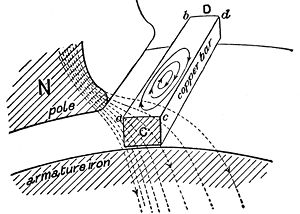Punx0r said:
I think you've got 6V P.D. across the right-hand side no matter how many fistfuls of diodes you throw at it. Maybe it's an over-simplification and not representative of a snap-shot of what goes on in a spinning motor fed by PWMed DC, but that's how I see it based on your sparse description...
It was just a thought experiment and has already served its purpose; but none the less, here's my take on it. Remember, the description starts with a normal, working motor, to which we add the zeners.
At any given point in the commutation cycle, two phases are excited. And we concentrate on one pair of adjacent windings of the two excited phases acting on a single magnet located somewhere between the two. In the normal motor, one will be pushing (repelling) that magnet, and the other will be pulling.
However, In our modified motor, one of the two phases will not be getting any EMF due to the presence of the zeners. For the sake of the experiment let's assume that its the pushing phase not getting any EMF.
So what happens. The puller still pulls; so the magnet still moves. As the magnet moves, its field will impinge upon both coils, and will still induce back-EMF in both of them. As you rightly pointed out earlier, in the puller phase, although the zeners prevent the back-EMF from flowing between coils, it is still there opposing the EMF that can flow into each turn of the coil; and the net effect is essentially the same as if the zeners were not in circuit.
Where it gets interesting is in the pushing phase. The absence of any EMF in the turns of that coil mean that the induced back-EMF has full reign to accumulate and flow throughout the coil. And, as when any current flows in a conductor, it will create a magnetic field around it. And the fields around the individual turns will accumulate and reinforce within the centre of the coil -- be that a stator tooth or an air core.
But as we know, the polarity of the back-EMF in that pusher coil will be reversed from that of the EMF that would flow were it not for the zeners. Likewise, the magnetic field it induces will be of opposite polarity to that which would have been produced by the EMF.
In other words, that coil will become a puller instead of a pusher with respect to the PM that is located between the two coils.
So, for each magnet, we have one coil to one side pulling, due to the field caused by the EMF. On the other side we have a second coil, also pulling
in the opposite direction, this time due to the field caused by the
back-EMF.
A tug of war where the EMF is working for us -- working to rotate the motor in our desired direction; and the back-EMF is working against us, trying to rotate it the other way.
Now, I asked what happened at switch on. When the EMF begins to flow, the motor is stationary, so there is no back-EMF; but equally, there is no EMF in one of the two phases, so we've effectively halved the torque of our motor. But, it still turns, and in the right direction.
As it turns, the blocked phase starts to produce back-EMF, that is attempting to turn the motor in the opposite direction. Of course, at low RPM, the magnets are moving slowly and so the back-EMF is minimal;
but still it is clear to see that the back-EMF is always working against our goal of rotating the motor in our desired direction.
And when the commutation direction reverse; all the forces involved are reversed; and the same thing occurs. That EMF that flows is working for us; and any back-EMF is working against us.
Bottom line: Just as you cannot have LIFT without DRAG; IT DOES NOT MEAN that (and I paraphrase) "DRAG is fundamental to how a wing produces LIFT". Hoards of aero-designers have spent the last 100+ years minimising DRAG in order to optimise the production of LIFT. Whether that's aimed at lifting more weight in a transport aircraft (analogy:traction motor); or to create the same lift from less thrust (and fuel) in a passenger jet (analogy:Sun Racer); or to allow a fighter plane to fly faster (analogy:Formula-E).
So, whilst you cannot have an electric motor without back-EMF; IT DOES NOT mean that "back-emf is fundamental to how a motor produces power".
Bland, meaningless aphorisms of this nature, and all that they imply, are why whilst the web has given us hugely greater access to a huge range of expertise; it has also given access to an even greater pool of 'armchair experts'; who's primary expertise is selling themselves as that which they are not. Discipulum cavete.



